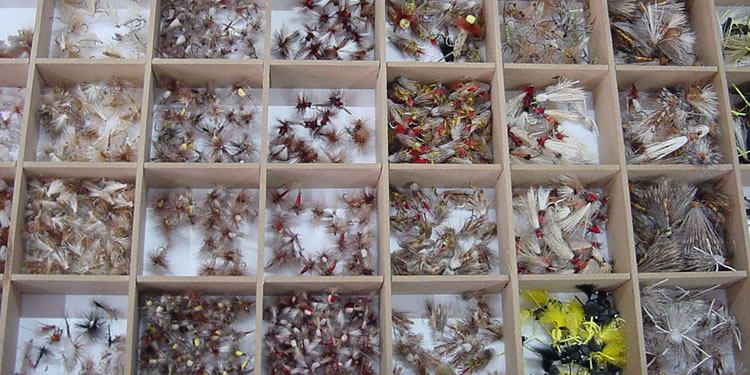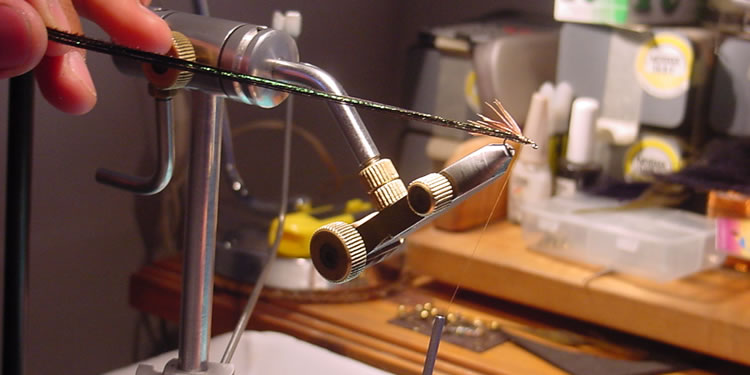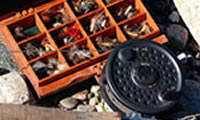The diet of all trout species is composed of aquatic and terrestrial insects, crustaceans, mollusks, and smaller fish species in every stage of their life cycle; i.e. eggs, larvae, and adults. When choosing an artificial fly to tie to the end of a fly-line, a fisherman must be conscientious of not making a selection based on personal taste or the myth that fly-fishing is just a question of luck. On the contrary, the sport of fly-fishing is based on the correct interpretation of what type and kind of insect fish are feeding on at any one particular moment.

The classification of an aquatic insect is one whose larval stage begins in the water, and the majority of whose adult life takes place in the vicinity of a water source. An aquatic insect's lifespan may last from one up to four years, depending on the insect species. Female insect species lay eggs in the water, the eggs then hatch a larva or nymph stage insect that lives in the water until adult maturity. Once an adult, aquatic insects leave the bellow water environment to live in the air for anywhere from a few hours or days, to a couple months. Examples of aquatic insects are: mayflies, caddis, stoneflies, dragonflies, damselflies, and mosquitoes.
The terrestrial insects that are capable of being imitated by fly-fishermen are those that live on dry land, near water sources, or that may somehow accidentally fall into the water and become a food source for fish. Examples of terrestrial insect that serve as fly imitations are: bees, ants, wasps, gatas peludas , and beetles.
Crayfish, pancoras, and freshwater shrimp inhabit the lakes and rivers throughout all of Patagonia . They are bottom-dwelling species and often are found inhabiting under large rocks and boulders. Examples of baitfish are minnows and the baby fish versions of the larger species that typically inhabit the mid-level depths of a river or lake. Baitfish are a large part of a trout's diet.

An artificial fly is classified as a "dry fly" when it floats on top of the water. This form of artificial lure is aimed at imitating an adult aquatic insect, or a terrestrial insect that has fallen into the water. Most often they are wing-based insects. In general, when fishing with a dry fly it is best to use a "floating line" which aids in keeping the lure buoyant. If a trout encounters an insect that normally appears on the surface of the water, sunken in a river's depths, it is intelligent enough to rapidly perceive it is being fooled, or that it is irrational that such an insect would appear. It must be kept in mind that trout completely understand an insect's expected appearance and behavior, even much better than humans.
Fly-fisherman use a "wet fly" or a "nymph" when they wish to imitate the larval state of an aquatic insect. In this case, the use of a "sinking line" aids in lowering the fly to the necessary depth of the river. Each sinking line has its own weight, and is classified by how many meters/feet it will sink per second (meters/feet x second) in an effort to locate a wet fly at the proper depth where a trout may be located. Fishermen select the "weight" of their sinking line by judging variables like the depth of the river and strength of the current.
The term "streamer" refers to an artificial fly that does not imitate a fly, but a small bait fish or minnow that inhabit a river's medium depth. In order to effectively fish with a streamer fly-fishermen must use a sinking line to achieve the proper depth.

There are two categories that fall under the greater classification of "artificial flies". One group are the "imitators", artificial flies that attempt to look and act like real-life insects.
The second group are "impersonators", which do not imitate any specific insect from reality. One could correctly say that what this second group impersonates more than anything are their fly-fishermen creators. Nonetheless, "impersonator" flies are successful at inviting strikes because they are either bothersome or irresistible to the trout that see them. Many believe that trout, as well as the major species of Hunter Fish, are territorial animals, causing them to attack anything that enters their territory that they perceive as threatening.